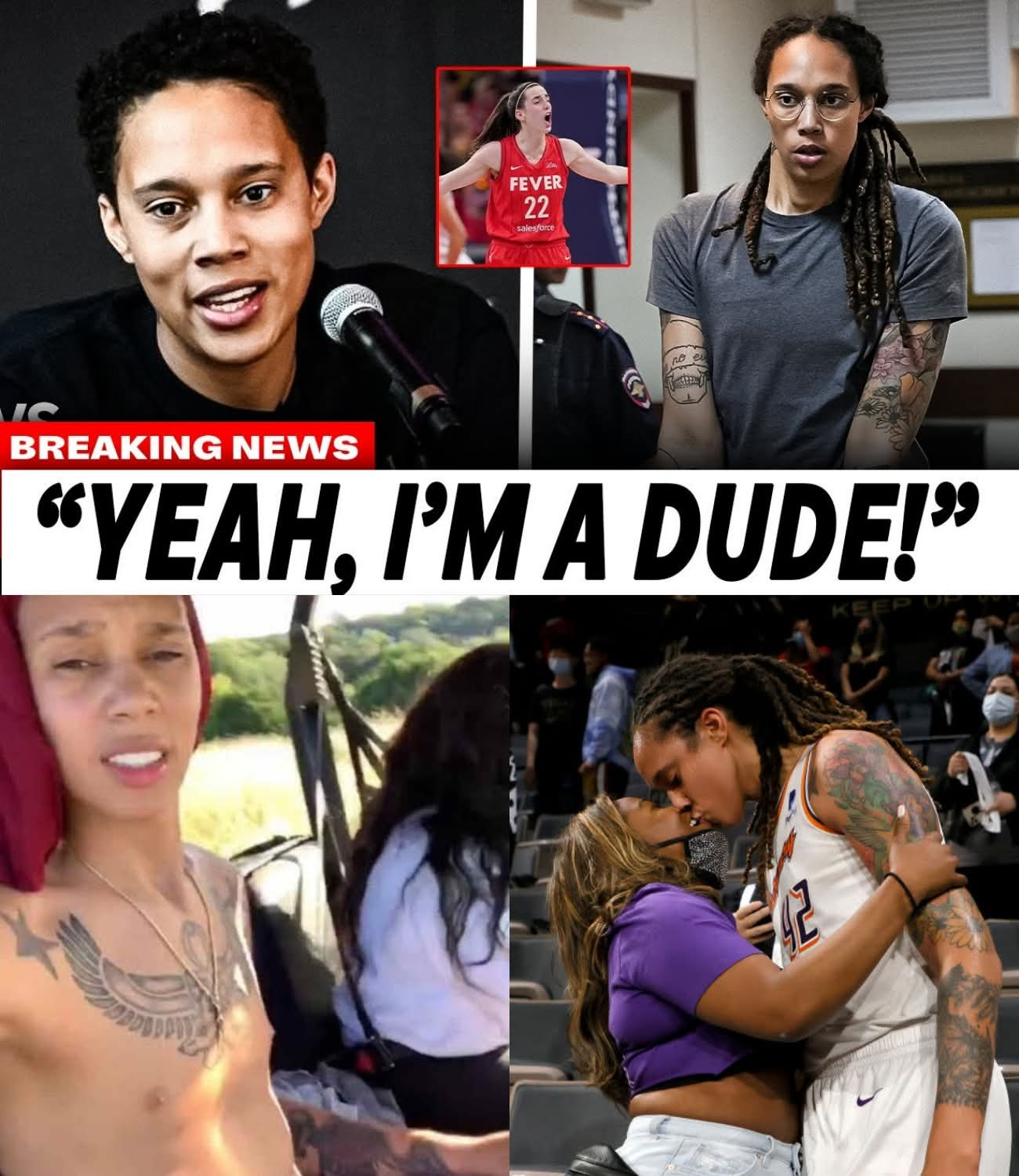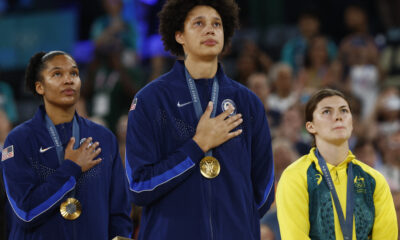NFL
Breaking:”I’M A GROWN MAN”: Brittney Griner’s Viral Outburst Ignites Explosive Debate Over Gender, Fairness, and the Future of the WNBA” Read more…

In a moment that ricocheted across the sports world like a thunderclap, WNBA star Brittney Griner stunned fans, critics, and even her own teammates when she shouted, “I’m a grown man!” during an on-court altercation with rookie phenom Caitlin Clark. The phrase—just four words—has since ignited a firestorm of speculation, controversy, and cultural debate that has left the WNBA reeling and the public bitterly divided.
The incident took place during a heated matchup between Griner’s Phoenix Mercury and Clark’s Indiana Fever, a game already saturated with tension as the veteran Griner faced off against the new face of the league. But no one could have predicted what would happen next. After being whistled for a hard foul, Griner turned toward Clark, clenched her jaw, and let the phrase fly.
“I’m a grown man.”
Captured on video and shared widely on X (formerly Twitter), the clip exploded. Lip-readers confirmed it. Memes sprang up within minutes. Commentators, analysts, and podcasters couldn’t talk about anything else. But beyond the internet frenzy lay a far more serious question—what did she mean?
FROM TRASH TALK TO NATIONAL TALK
At first glance, the outburst might seem like nothing more than aggressive trash talk—Griner’s way of asserting dominance in a league where competition is fierce. But the internet rarely stops at face value.
Almost immediately, the phrase was dissected for deeper meaning. Was it just swagger, or was it something more revealing? Was it a slip? A metaphor? Or, as some online commenters suggested, a coded confession?
The conversation quickly spilled beyond sports media into broader cultural battlegrounds: gender identity, intersex biology, and fairness in women’s sports.
THE INSTAGRAM LOOPHOLE THAT FUELED SUSPICION
One of the strangest and most controversial elements came not from the court, but from social media history.
Internet sleuths unearthed a topless Instagram story posted by Griner years ago—one that somehow slipped past Meta’s automated censorship filters. The platform’s nudity AI, known for aggressively flagging female-presenting bodies, had let Griner’s post stand. Why?
That question opened the floodgates.
Some theorized that Instagram’s AI had registered her body as male. Others suggested this was evidence of an intersex condition or prior hormone treatment. Nothing about the post was illegal, but everything about it was interpreted as suspect.
LEAGUE SILENCE VS. INTERNET NOISE
The WNBA has long positioned itself as an inclusive, forward-thinking organization. But in this case, the league’s silence has only added fuel to the fire.
Currently, the WNBA enforces strict hormone level requirements for transgender athletes but says little about intersex conditions. No public documents indicate that Griner has undergone hormone therapy or gender reassignment. Nor is there any evidence of rule violations. But as speculation builds, so too does pressure on the league to clarify its policies and investigate.
Inside the league offices, sources say the mood is tense. Emergency meetings have been held. Sponsors are asking questions. And some team owners are quietly pushing for transparency—while others worry that such an inquiry would cross ethical lines and violate player privacy.
THE FAIRNESS DEBATE GOES MAINSTREAM
At the heart of the controversy is a single, uncomfortable question: What makes competition fair in women’s sports?
For some, Griner’s size, strength, and athleticism have always raised eyebrows. At 6’9” with a dominant post presence, she has reshaped the WNBA since her debut in 2013. But now, in light of the viral video and resurfaced social media posts, critics are demanding to know whether she may have benefited from biological traits they argue could give her an edge.
“There’s a difference between elite training and hidden advantages,” said one anonymous WNBA player in an interview. “We need transparency. Otherwise, we’re playing blind.”
But others fiercely defend Griner.
“She’s a champion, a gold medalist, and a survivor,” tweeted one former player. “The idea that we’re questioning her right to play now—after all she’s done—is insulting.”
CAITLIN CLARK CAUGHT IN THE CROSSFIRE
Ironically, Caitlin Clark—whose presence on the court seemed to trigger the viral moment—has remained largely silent on the controversy.
Her only public comment? A short, poignant post: “I love this game and everyone who plays it. Let’s keep the focus on basketball.”
But silence hasn’t spared her from becoming a flashpoint. Her rapid rise, record-breaking attendance draws, and predominantly white fan base have only deepened longstanding racial and cultural divisions within the league.
Griner has hinted that the media’s adoration of Clark has racial undertones, suggesting Black athletes have long been overlooked. Whether one agrees or not, the tension between past and present stars has now turned personal—and very public.
SPONSORS, STAKEHOLDERS, AND A LOOMING CRISIS
Behind closed doors, the financial side of the league is also at risk.
Several sponsors are said to be re-evaluating their positions. While some see controversy as an opportunity for increased engagement, others worry that unresolved questions could spiral into a PR disaster.
“If the league doesn’t address this soon,” said one brand executive anonymously, “it’s going to look like a cover-up. And no sponsor wants to be part of that narrative.”
WHERE DOES THE WNBA GO FROM HERE?
The options are limited—and dangerous.
One route would be to mandate hormone testing or expand eligibility rules for all players. But that would ignite backlash over bodily autonomy, privacy, and discrimination.
The other option is to do nothing and risk the integrity of the league being questioned in perpetuity.
The truth is, this moment is bigger than Brittney Griner. It’s a litmus test for professional sports in a rapidly changing world. How do leagues balance inclusion with fairness? How do they respect player identities while protecting competitive integrity?
The answers are elusive, but the stakes are real.
A MOMENT THAT WON’T FADE QUIETLY
The phrase “I’m a grown man” may have started as a viral soundbite, but it has become something far more volatile—a flashpoint in one of the most contentious debates in modern sports.
For now, Griner remains silent. The league remains silent. But the public isn’t.
Whether it ends in policy change, legal action, or quiet dismissal, the fallout from this one moment is far from over.
And as the WNBA inches closer to its next season, one thing is clear: the silence won’t hold much longer.
SEE MORE: Caitlin Clark’s impact on the WNBA could eclipse ‘a billion dollars’
The impact of the Indiana Fever star goes well beyond the basketball court. In her second season, Clark is also changing the league’s bottom line.
When the WNBA returned to action last week, Ryan Brewer, like many who follow the league, was curious to see how Indiana Fever star Caitlin Clark might top her rookie-of-the-year season.
Yet the interest of Brewer, an associate professor of finance at Indiana University Columbus and an expert at valuations, goes beyond Clark’s box-score averages. After Clark’s phenomenal popularity spiked attendance and merchandise sales and drew historic television ratings wherever the Fever played in 2024, Brewer was asked by the Indianapolis Star to evaluate her economic impact on the WNBA. He determined Clark was responsible for a staggering 26.5% of all WNBA economic activity last season, including revenue from merchandise, ticket sales and television.
When Brewer crunched the numbers to analyze her potential impact in 2025, he arrived at a valuation that “is quite impressive,” Brewer said.
“If things just go as they were, and we have an expanded season of 22 home games with modest inflation, I’m looking at $875 [million],” Brewer told NBC News. “And I could easily see that eclipsing a billion dollars on the economic impact of Caitlin Clark this year.”
The WNBA’s 29th season opens at a time when its basketball is impossible to untangle from its bottom line. And Clark has played a propulsive role in both.
For the first time since 2008, the WNBA expanded this season to add a 13th team, the Golden State Valkyries. Next season, two more will debut in Toronto and Portland. As the WNBA’s footprint grows, so do its coffers. In 2026, the league will enter the first year of an 11-year media-rights deal worth a reported $2.2 billion overall that is expected to triple its current media-rights revenues. (One of the media partners is NBC, which shares a parent company with NBC News.)
“Her ability to fill up stadiums is amazing,” he said.
And that interest has been felt strongly in Indianapolis, where a $78 million practice facility solely for the Fever is under construction.
In 2024, after Indiana drafted Clark No. 1, Visit Indy, a nonprofit that promotes tourism to the city, sprung into action. It placed paid advertising throughout Iowa, including on social media, to test whether Clark’s die-hard collegiate fans might have an appetite to make the trip to Indiana to watch her as a pro. Soon, visits to pages on Visit Indy’s website dedicated to the Fever increased by 501%, said Chris Gahl, Visit Indy’s executive vice president and chief marketing officer. Fever home games also corresponded with a bump in booked hotel rooms in the city, he said.
Part of Gahl’s job is to persuade those in charge of booking large, corporate meetings and conventions to host them in Indianapolis. Last year, he found a new way to entice nearly 50 planners to check out the city for the first time: Taking them to a Fever game.
The planners, who were predominantly women, “would not have traveled here and visited here were it not for the invitation for them to come see a home Fever game,” Gahl said.
“An Indiana Fever home game is a very hot ticket.”
Related Posts


















